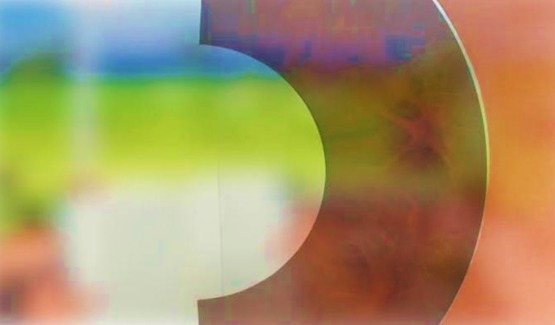Humans have the Ability to see UV light, but it is filtered by the eye’s lens. People who have surgery to remove the lens can see UV light. The condition is known as Aphakia.
Aphakia means the absence of lens from the eye but from the optical point of view it may be considered to be a condition or conditions in which the lens is absent from the pupillary area. In most of the cases it is due to operative removal of the crystalline lens. In some of the cases lens may dislocate in the vitreous chamber. Rare causes are absorption, traumatic, extrusion, and congenital absence of lens.
Optics of Aphakia
Aphakia is an extreme from of hypermetropia. After removal of the lens the total refractive power of the eye is reduced to 43.05 D. There being only one main refracting element, i.e., the cornea, this is more near to the concept of Donders’ reduced eye. The two principal points are almost at the anterior surface of the cornea. The nodal points are very near each other and about 7.754 mm from the anterior surface of the cornea which shows that both the principal points have shifted forwards in the uncorrected eye. The nodal points also shift. In the uncorrected eye they shift backwards. In the corrected eye, however, they shift forwards. The parallel rays of light are brought to a focus about 31 mm behind the cornea while the eye is 23-24 mm long. In aphakia the anterior focal point is at 23.22 mm (normal is 17.05 mm). The dioptric system of the eye must, therefore, be supplemented by a strong converging lens. If the eye was emmetropic before the development of the cataract the correction required is about 10 diopters. The relationship of aphakic refraction to preoperative ametropia is not straightforward. If ametropia is of index type, e.g., myopia in nuclear cataract, the post-operative refractive error would be identical with an operated emmetropic eye. Axial ametropia, however, makes a difference. The power of lenses required after operation can, roughly, be calculated by the formula +10 D sph. +1/2 the dioptric power of the pre-existing glasses. For example, for myopia of -10 D the new number required would be +10 D + (1/2 of – 10 D, i.e., -5 D) or +10 D – 5 D = +5 D and for – 20 myopia it would be + 10 – 10 D = 0.00 D. For hypermetropia of +5 D it would be +10 D +(1/2 of +5D or +2.50 D) or + 10 D + 2.50 D sph. = +12.50 D. This is only a guideline and may not eventually be true because of varying factors in the etiology of the error.
However in some clinics these days axial length of the eyeball is determined by using ultrasonic methods employing computerized determination.
Corneal astigmatism is always present and is attributed to the operative scar. It is against the rule and is +8 to +10 diopters about a week post operatively and is gradually reduced to about +2 D in six weeks time. The downward trend may continue for as long as 3 months or so. If there be a pre-existing error of astigmatism it gets added algebraically. Since the ultimate astigmatism due to operative scar is unpredictable, it is not possible to mathematically calculate the astigmatic error. In view of this it is not advisable to prescribe glasses earlier.
If glasses are insisted upon they should only be temporary and preferably only spherical. Temporary correction has the advantage that the patient can somewhat adapt himself to the new vision. For distance the average correction is +10.00 D sph. (sometimes +11.00 D sph.). Correction is also needed for reading distance which varies from +3.00 to +4.00 diopters depending upon individual needs of the patient.
Spectacle frame should be well fitting, otherwise the weight of thick convex lenses would sag them down thus changing the effective power of the lens. The precise distance between the cornea and the back of the trial lens should be supplied to the optician. The weight of the glass can be reduced if hardened plastic lenses are used. The plastic lenses have a disadvantage of being scratchable.
The aphakic eye has several handicaps as a visual apparatus.
- Size Of The Image: The image size increases by about 30%. It has been stated earlier that if the correcting lenses are worn at the anterior principal point the size of the retinal image is uninfluenced by a correcting lens. This statement does not hold good for aphakic. The size of the image varies in comparison with that of an emmetropic eye by an amount depending on the difference between their anterior focal distance. On calculation the ratio works out to be 1.36 to 1, i.e., the image in the aphakic eye will be about 1/3 larger than in an emmetropic eye even when in each case the lens is worn at the anterior focal distance will get varied. The increase in the size of the image is larger if the eye was previously myopic and there is lesser increase in the size if the eye was hypermetropic pre-operatively.
- Vision in Aphakia: A large image falsifies the visual acuity recorded on the Snellen’s chart. The vision recorded is theoretically better than the actual visual acuity in terms of visual angles. A vision of 6/9 in a corrected aphakic eye should be regarded as equivalent to 6/12 in an emmetropic eye or in an eye whose optical system in unaltered.

- Accommodation: Due to absence of lens it is totally abolished. It is impossible to prescribe lenses which could permit a visual range from infinity to near point. In practice one prescribe.
- A pair of glasses for distant vision and another pair for near vision, or
- Some persons prefer to prescribe one for distance and the other pair for bifocal for near and intermediate distance.
The author prefers to follow the first alternative. The patient learns to achieve some elasticity by increasing or decreasing the distance at which the lens is worn by shifting the spectacle frame.
- Aberration: There is a spherical aberration. The phenomenon is termed as pin-cushion distortion. In this the straight lines become curves and the linear world becomes one consisting of parabolas which continually change their shapes when the patient moves the eyes. When the objects are viewed through the periphery, they look enlarged, nearer and enlarged, nearer and elongated in radial direction. When the objects are moving they appear to be moving faster.
On lateral movement there is a prismatic effect, and more than 2 to 3 prism diopter effect is rarely tolerated.
When the objects or lights are viewed from the periphery of the lens there is also a chromatic aberration.
Aspherical lenses though mitigate these effects yet seldom are the answer to these problems. Conoid cataract lenses, which have an ellipsoid of revolution as the front surface and optically correct the aberration inherent in spherical lenses, can be employed. In these lenses the gradually reduces from the center to the edge.










